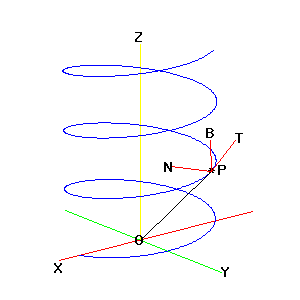|
Egwald Mathematics: Space Curves
by
Elmer G. Wiens
Egwald's popular web pages are provided without cost to users.
Follow Elmer Wiens on Twitter:

Space Curves
Suppose that the location of the point P(x,y,z) in three dimensional space is determined as a function of time t. Specifically, suppose that:
x = x(t), y = y(t), z = z(t)
Thus, each component of P is a separate function of time. Then as t varies, the locus of P is a curve in three dimensional space.
For example, the following equations will trace a circular helix.
x = a * cos(w * t), y = b * sin(w * t), z = c * t
|
In the example to the right,
|
a = 1.5, b = 1.5, c = .1,
w = pi/6, 0 < t < 40
|
T = the tangent to the curve at P
with t = 16
|
|
N = the normal to the curve at P
|
|
B is perpendicular to T and N
|
|
B = T X N, where X denotes cross product
|
|
The system of mutually orthogonal vectors, T, N, and B, is used extensively in analyzing space curves in general.
|
|

|
Let the vector from the origin to the point P be R. Let s be the arc length along the space curve from P to another point P0. Then
R = i * x(t) + j * y(t) + k * z(t)
where i, j, and k are the unit vectors along the x, y, and z axis, respectively.
For a circular helix:
R = i * a * cos(w * t) + j * b * sin(w * t) + k * c * t
To obtain the unit tangent vector, T, to the space curve at P, differentiate R with respect to s:
T = dR / ds = { i*(-a*w*sin(w*t) + j*(b*w*cos(w*t)) + k*c } dt / ds
For T to be a unit vector requires that the magnitude of T be 1. So,
dt / ds = 1 / sqrt[w2 * (a2 * sin2(w*t) + b2 * cos2(w*t)) + c2] = kap.
To obtain the unit normal vector, N, to the space curve at P, differentiate T with respect to s, dT / ds = kappa * N, with |N| = 1.
dT / ds = (dT/dt)/(dt/ds) = kap * { i*(a*w2*cos(w*t) + j*(b*w2(sin(w*t))} * dt / ds
|dT/ds| = kappa = kap2 * w2 * sqrt[ a2*cos2(w*t) + b2 * sin2(w*t)]
Kappa is the curvature of the space curve at P.
Notes:
1. The velocity vector, V(t) = dR / dt, in the direction of T, is given by
V = dR / dt = i*(-a*w*sin(w*t) + j*(b*w*cos(w*t)) + k*c.
2. The acceleration vector, A(t) = dV / dt is given by
A = dT / dt = i*(a*w2*cos(w*t) + j*(b*w2(sin(w*t)).
3. When a = b, matters simplify because cos2(w*t) + sin2(w*t) = 1. Then
kappa = a * w2 / (a2 * w2 + b2)
|










